Types of Macaws: The Ultimate 18 Species and Fact
Macaws are vibrant, intelligent parrots from Central and South America. Colored plumage and loud calls, and sociable nature in macaws make them the largest parrot species. Their long tails and sturdy beaks make them a favorite both in the wild and as pets.
Table of Contents
Worldsultimate will list information on the 18 types of macaws, including the macaws’ habitat, conservation status, and what makes each species remarkable.
Ancient Cultures and History
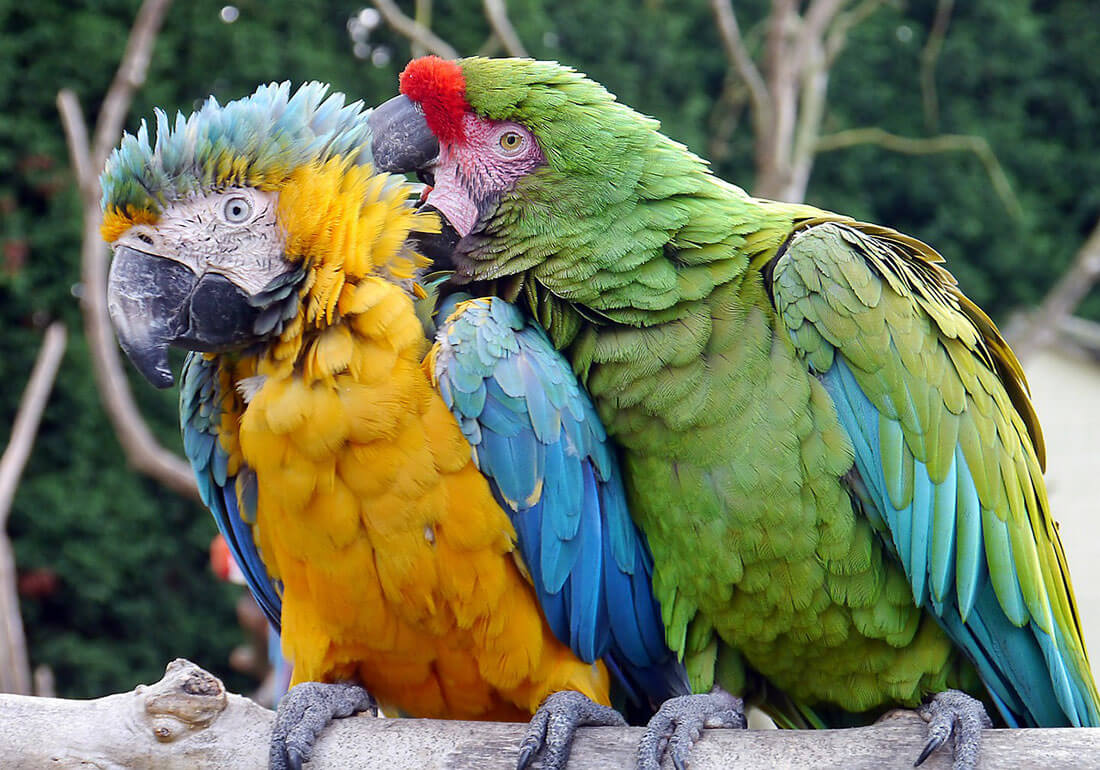
Indians living in 1536 occupied areas that are known as New Mexico and Arizona today and these Indians trade for parrot feathers. In 1716, Indians were referenced by Padre Velarde to raise these beautiful birds so that they can utilize the feathers as adornments. Another tribe, Pueblo Indians used to raise macaws and other types for their beautiful feathers which were used for enhancement.
During the twentieth century, many of the macaws were exported to the US and Europe. But after World War II and several bird disease outbreaks, the trade was prohibited in many countries. There is still an existing population of macaws in captivity through breeding programs today.
Fascinating Facts
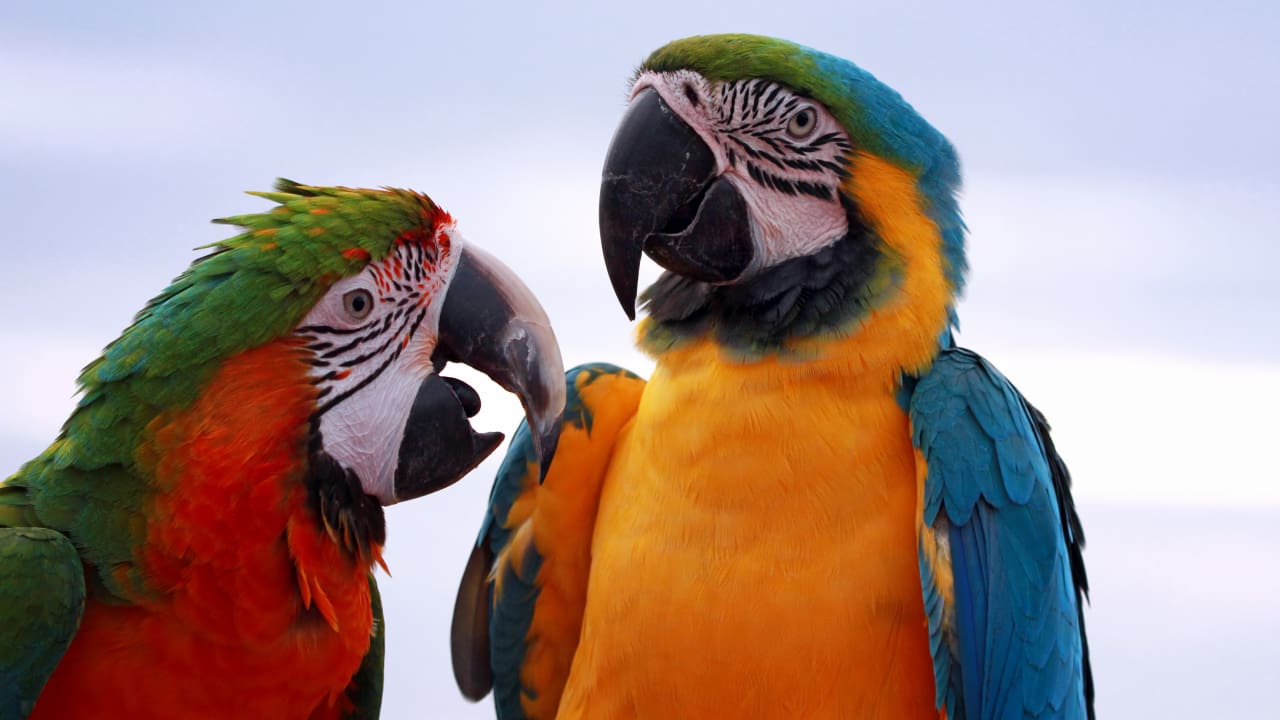
Adaptations for the Rainforest Macaws have sprightly feathers whose colors are suitable to life in Central and South American rainforests. The birds have large and strong mandible that easily cracks nuts. Moreover, while their scaly tongues have a bone inside them that makes them an effective tool for tapping into fruits. Macaws also have gripping toes that they use to hold and examine items.
- Rainforest Adaptations: Macaws have brilliantly coloured feathers, which help them blend into the tropical canopy.
- Powerful Beaks: The big beaks of these birds can easily break nuts, seeds, etc.
- Clever Tongues: A bony structure in their tongues enables them to use their tongues more efficiently when manipulating their food.
- Zygodactyl Feet: Two toes that point forward, and two that point back, to help grip and climb.
Behavior and Intelligence
Macaws are intelligent birds that often gather in flocks. Their loud calls and squeals echo thunder through the forest canopy. They are flock birds, and you can frequently witness them flying in pairs or groups. Their calls can be as loud as thunder and reverberate through rainforests, and some can even mimic human speech. They are curious, social, and require significant mental workouts.
You Might Like to Read: How to Teach Your Macaw to Talk?
At night, the flocks roost in the treetops and, by morning, they may travel long distances to forage for fruits, seeds, insects, and snails.
Reproduction
Macaws tend to stay with their partner for life. Males and females share duties: the female incubates eggs while the male forages and brings back food. Bonding is evidenced by mutual feeding and grooming.
Habitat
The appealing macaws with sparkling and attractive bodies are found in Mexico, Central and South America, and previously in the Caribbean.
1. Macaws in the Wild
Macaws are mostly found in largest tropical rainforests. The Red-fronted Macaws are also found in semi-desert regions and the Yellow-collared Macaw inhabits grasslands. Those that live in the forests are found primarily in rainforests and they build their nests in holes of trees and eat the seeds found in the canopies.
Hence, even in the circle, the rainforest, macaw habitats differ between species, such as the lowlands are the habitat for Scarlet Macaws, whereas the Red-bellied Macaws are found in swampy areas. The Hyacinth Macaws move with the seasons, going from open canopies to mature palm rainforests, and then to a more open country of grassy marshes.
2. Where Do Macaws Live?
Macaws are native to Mexico, Central America, South America, and formerly the Caribbean. Rainforests, specifically the Amazon rainforest, swamps, grassland, and even semi-desert areas are their habitats, depending on the species. For example:
- Scarlet Macaws – Lowland rainforests
- Red-bellied Macaws – Moriche palm swampy forests
- Yellow Collared Macaws - Grasslands and wooded areas
- Hyacinth Macaw – Seasonally migrates between forest types
3. Macaws as Pets
A lot of macaws are kept as pets because of their human-like abilities, beauty, and the extensive emotional bond they can build with their owners. However, they require:
- Large space
- Social interaction
- Mental stimulation
- Special diets
Mini macaws (Hahn’s and Yellow-collared, for example) are more manageable for home environments.
Endangered Birds
All types of Macaws living in the wild are endangered. Most of them are threatened with extinction. With a combination of factors, including the destruction of the rainforests and their natural habitats, hunting, and collection for the pet trade. All the types of Macaws are subjects of conservation and listed on the IUCN (Red List of Threatened Species). Some Macaw species are extinct, and the couple has not been seen in many years and is thought to be gone or close to extinction. All show signs of diminishing their populations.
Currently, the IUCN shows that two of the Macaw species are critically at risk, three species are endangered. Moreover, one is threatened, two are unguarded, and nine are of least concern.
Nearly every macaw species is threatened, endangered, or vulnerable. The main threats include:
- Deforestation
- Illegal pet trade
- Hunting
As per the IUCN Red List:
- 2 species are Critically Endangered
- 3 are Endangered
- 1 is Near Threatened
- 2 are Vulnerable
- 9 are of Least Concern
Some species, like the Glaucous and Spix’s macaws, could already be extinct in the wild.
Types of Macaws as Pets
1. Red-shouldered Macaw (Diopsittaca nobilis)
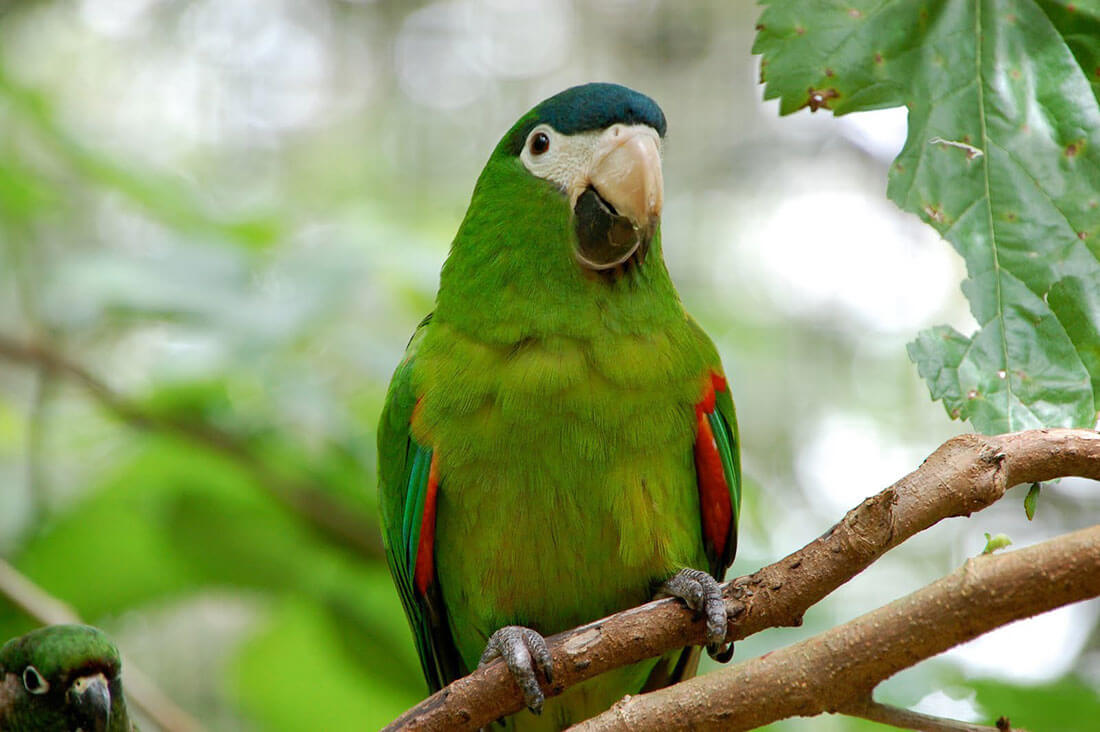
| Size | 30–35 cm (smallest macaw) |
| Habitat | Lowlands, savannahs |
| Status | Least Concern |
| Fact | Includes Hahn’s and Noble Macaws |
These are named for the red wing coverts, live in South America. It is the smallest species of macaw with a length ranging between 30-35 cm. The bird is native to the savannah, swamplands, and tropical lowland habitats. Moreover, the red-shouldered Macaw has two subspecies, the Hahn’s and the noble Macaw.
2. Yellow or Golden-collared Macaw (Primolius auricollis)
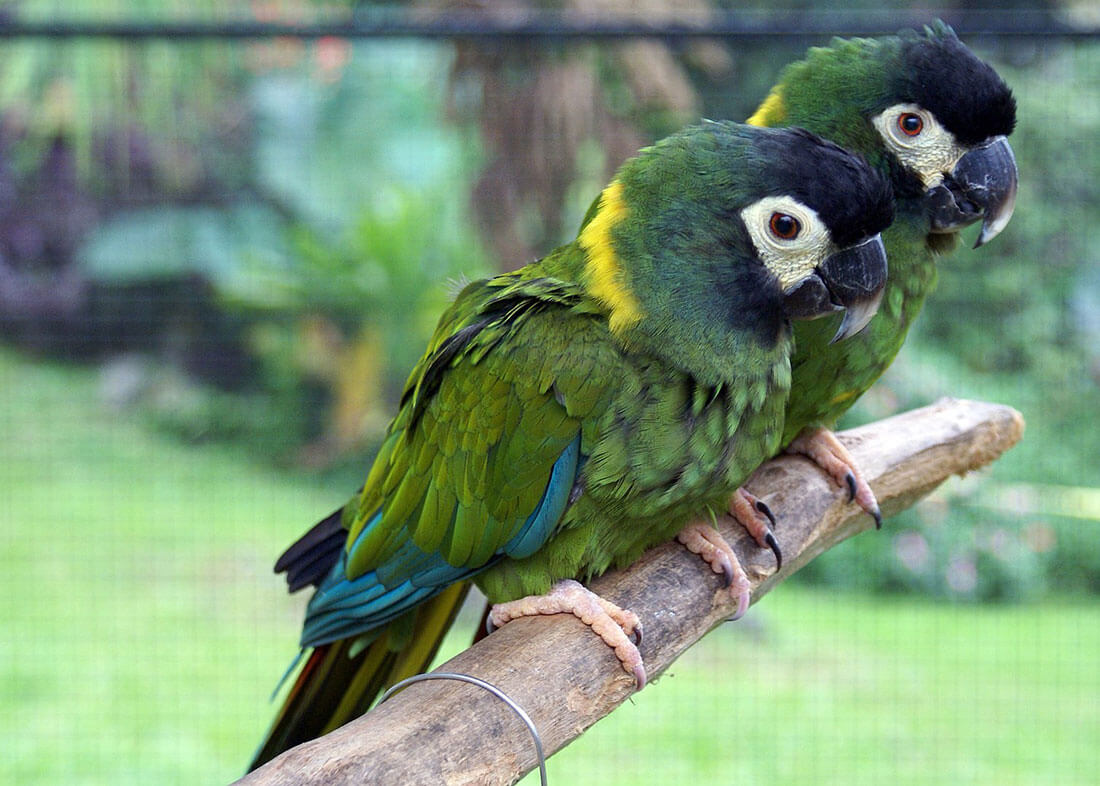
| Size | 38–40 cm |
| Habitat | Pantanal, Brazil |
| Status | Least Concern |
| Fact | It doesn’t exist in the Amazon Rainforest! |
This is a Central South American macaw that has a bright yellow patch at the back of its neck which justifies its name. The main population of the Yellow-collared macaw lives in the Pantanal of Brazil. Mostly found in lowland habitats but in some location live at altitudes up to 5,600 feet. These types of macaws are not found in the Amazon Rainforest but inhabit other forests, savanna, woodlands, and grasslands.
3. Blue or Illeger’s-winged Macaw (Primolius maracana)
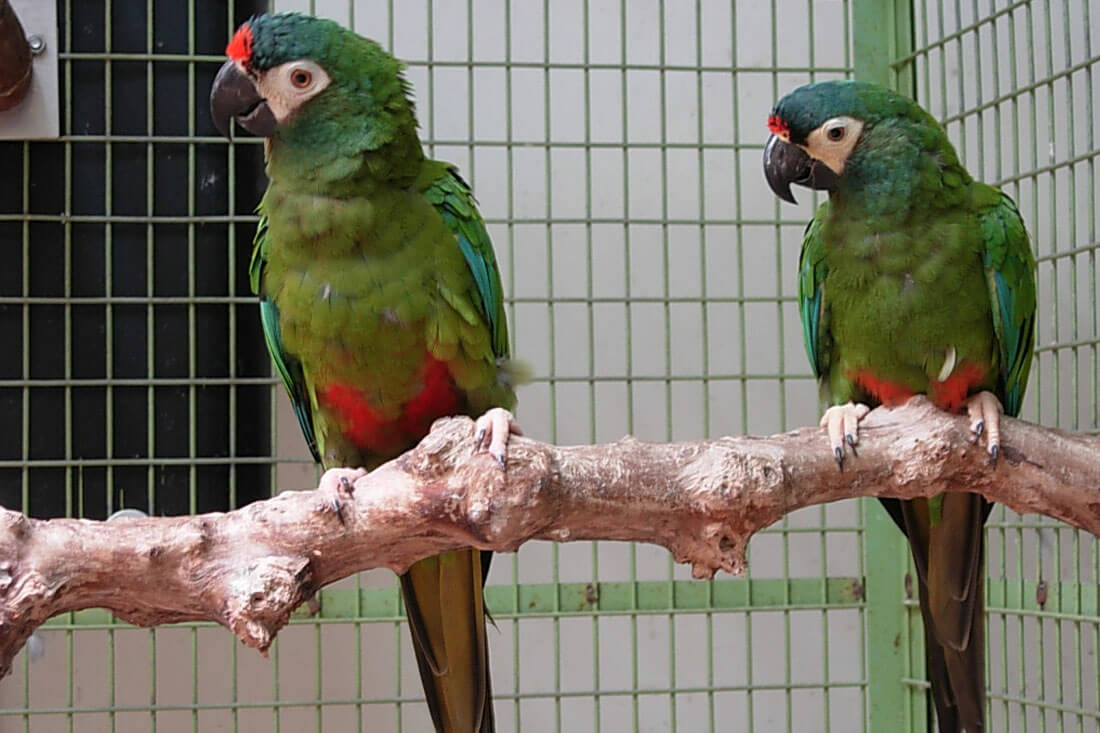
| Size | 40–43 cm |
| Habitat | Eastern and central South America |
| Status | Near Threatened |
| Fact | Also called Blue-winged Macaw |
These types of macaws are found in eastern and central South America. These birds inhabit both evergreen and deciduous forests. Unfortunately, deforestation and caged bird trade threat the birds and the IUCN declares them as nearly threat.
4. Blue or Coulon’s headed Macaw (Primolius couloni)
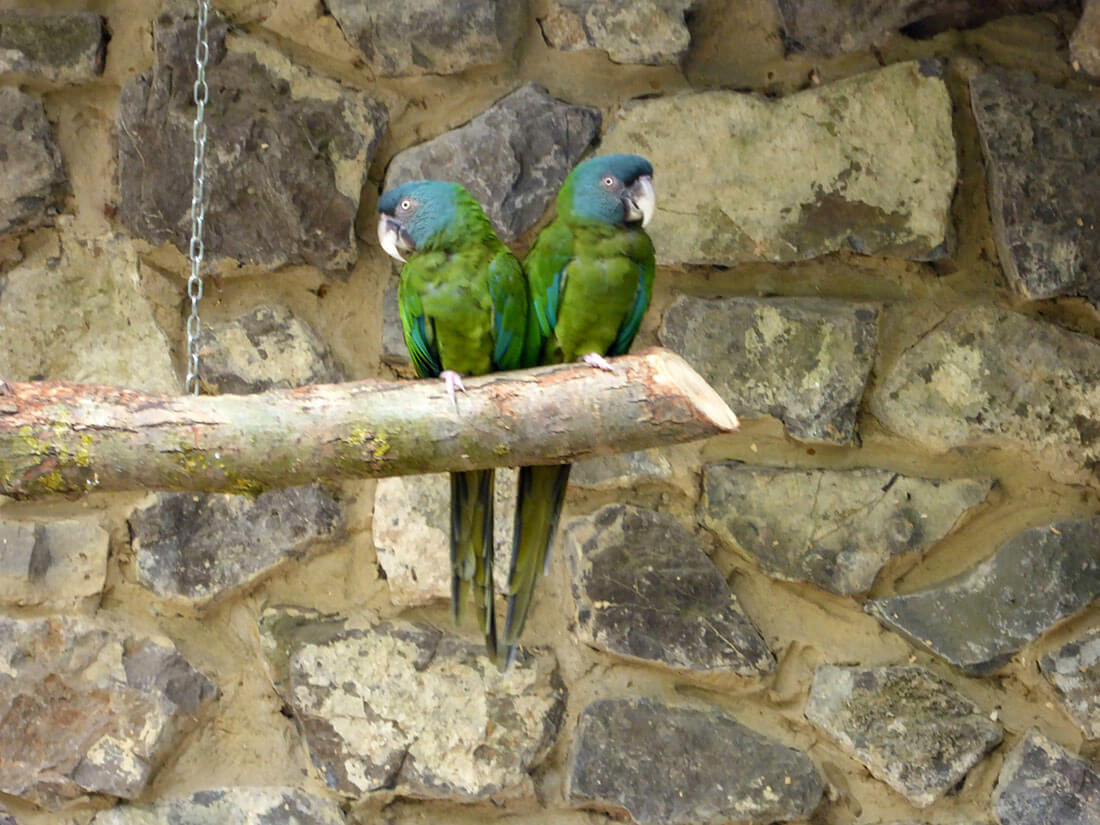
| Size | 41 cm |
| Habitat | Peru, Bolivia, Brazil |
| Status | Vulnerable |
| Fact | Endangered from deforestation and the pet trade |
The habitat of this macaw is Peru, Bolivia, and far western Brazil. The bird is classified as vulnerable and threatened by habitat loss and capture for the pet trade.
5. Red-bellied Macaw (Orthopsittaca manilatus)
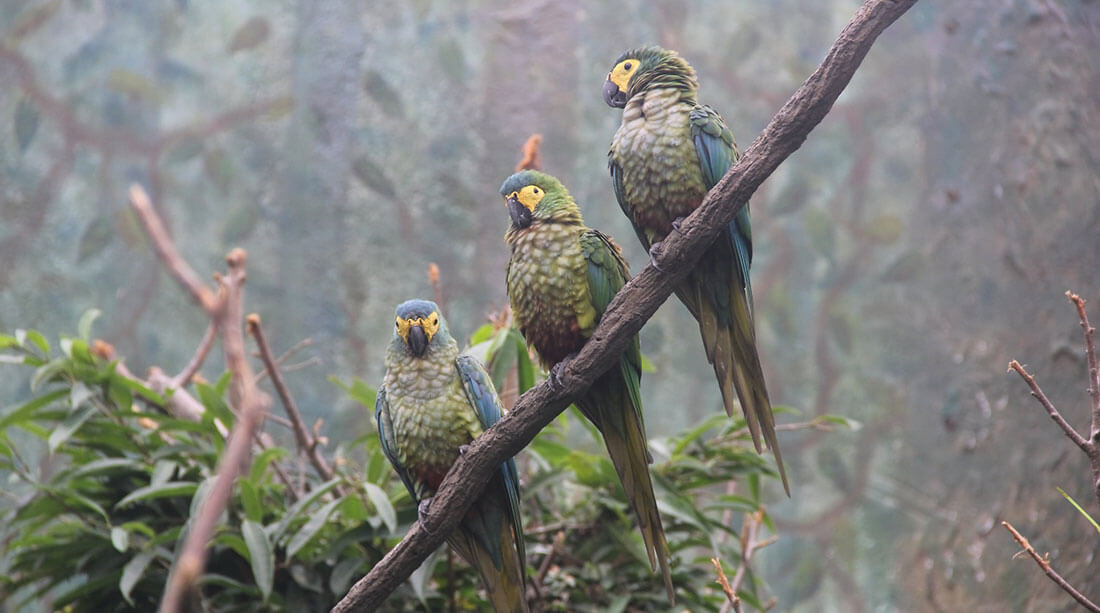
| Size | 46 cm |
| Habitat | Amazon Basin palm swamps |
| Status | Least Concern |
| Fact | Hard to imprison in a cage |
The red-bellied macaw is a medium-sized macaw living in South America. The belly of this bird has a large maroon patch which led to its name. The bird is endemic to the tropical Amazon forests of the continent. The range of the macaw includes Colombia, Trinidad, Peru, Bolivia, and Brazil.
The bird inhabits the moriche palm swamp forests and the palm groves of savannahs within its range. The clearing of the palm vegetation for human uses and capture of the birds for the pet trade threatens the survival of this bird.
6. Chestnut-fronted Macaw (Ara severus)
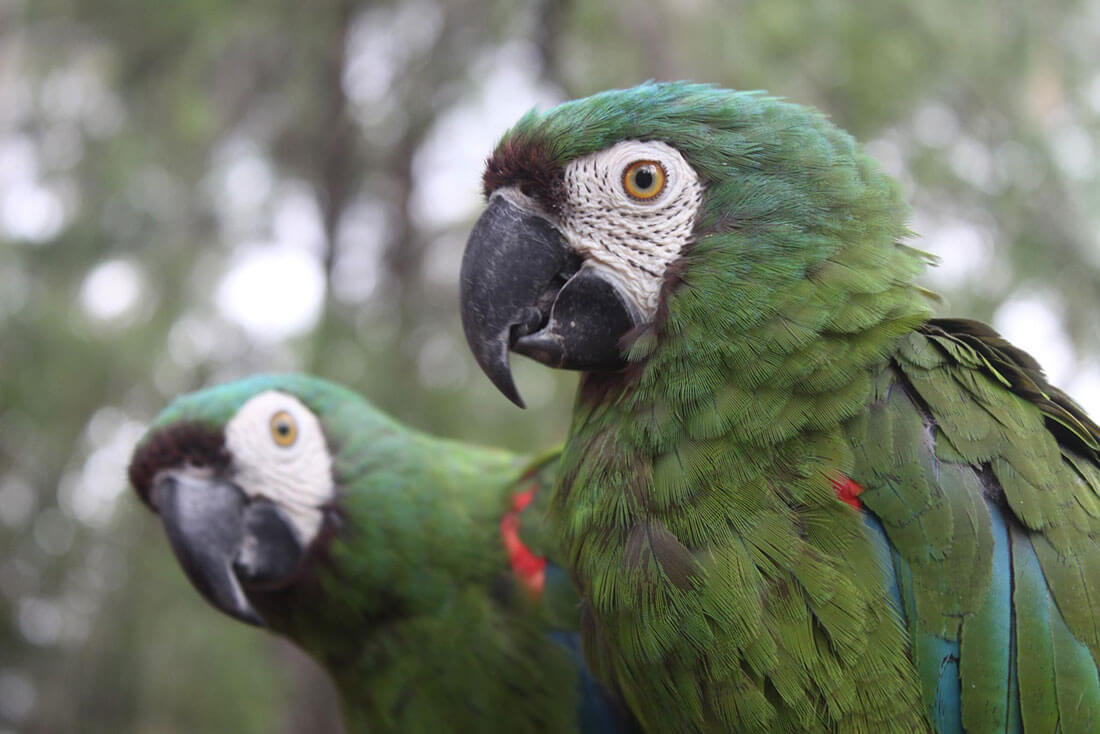
| Size | 45–50 cm |
| Habitat | Northern South America |
| Status | Least Concern |
| Fact | They are also called by the name Severe Macaw |
Severe Macaw / Chestnut-fronted Macaw lives in northern South America, where its range stretches from Panama to Amazonian Brazil to Bolivia. The birds have a long lifespan of 30-80 years. Although the macaw is mostly green-colour. Moreover, it possesses a chestnut brown patch above its beak.
7. Red-fronted Macaw (Ara rubrogenys)
| Size | 60 cm |
| Habitat | Bolivia’s dry valleys |
| Status | Endangered |
| Fact | Attempts are made to save it through captive breeding programs |
The red-fronted macaw is endemic to Bolivia’s mountainous areas. The species is classified as endangered. Moreover, bred in captivity to ensure the survival of the species.
8. Green or red-and-green-winged Macaw (Ara chloropterus)

| Size | 90–95 cm |
| Habitat | Central and northern South American forests |
| Status | Least Concern |
| Fact | Frequently mistaken for Scarlet Macaws since they share a similar color |
This macaw is another vibrant species of macaw featuring bright red feathers. These birds inhabit the forests and woodlands of South America’s central and northern parts. Although they are still widespread in distribution, their species is subject to the same common threats.
9. Scarlet Macaw (Ara macao)
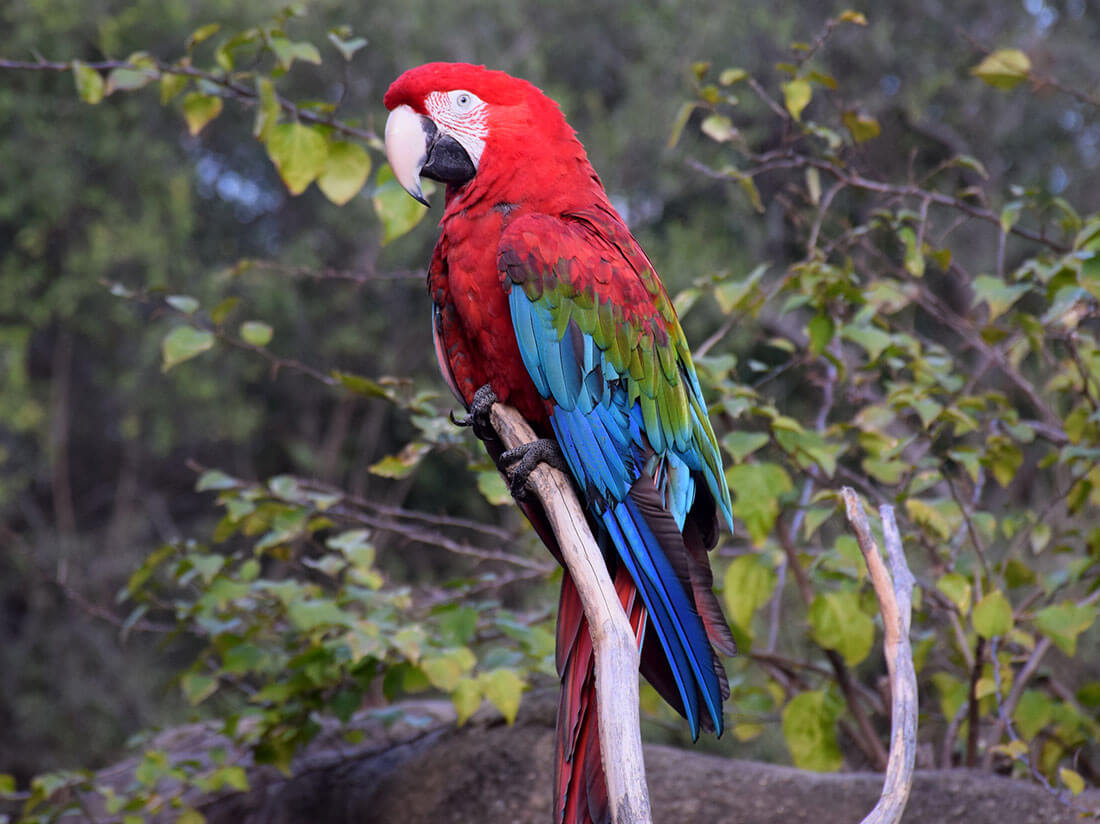
| Size | Up to 90 cm |
| Habitat | Tropical rainforests |
| Status | Least Concern |
| Fact | Its red, yellow, and blue plumage is what it is well-known for. |
The scarlet macaw is a large bird with brilliant red, yellow, and blue coloured feathers. The macaw is native to tropical South America’s humid evergreen forests. These birds have dwindled due to habitat loss and illegal capture for the pet trade.
10. Great green or Buffon’s Macaw (Ara ambiguus)
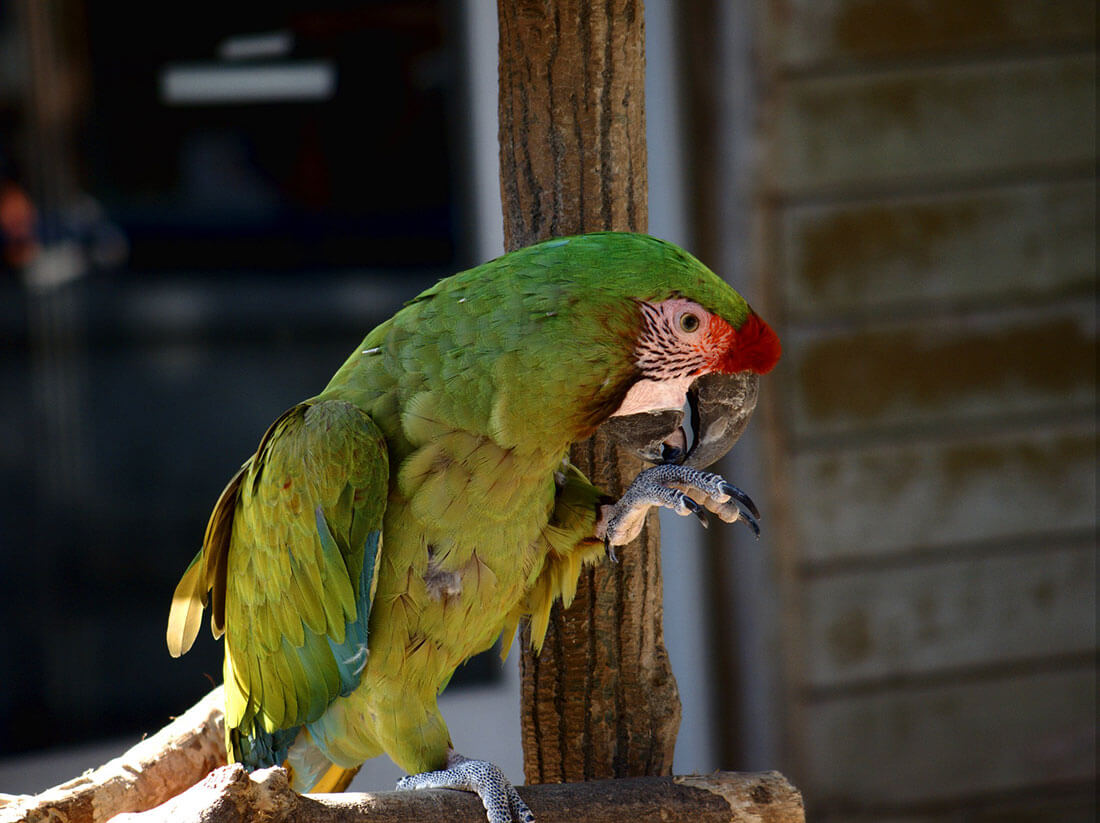
| Size | 85–90 cm |
| Habitat | Canopy of moist tropical forests |
| Status | Endangered |
| Fact | Dependent on almond trees |
This macaw lives in Central and South America. Within its range, the bird inhabits the canopy of wet tropical forests where it is highly dependent on the almendro tree. Habitat loss due to the harvesting of the almendro tree for wood and the replacement of forest land by agricultural land threaten the populations of the great green macaw.
11. Military Macaw (Ara militaris)
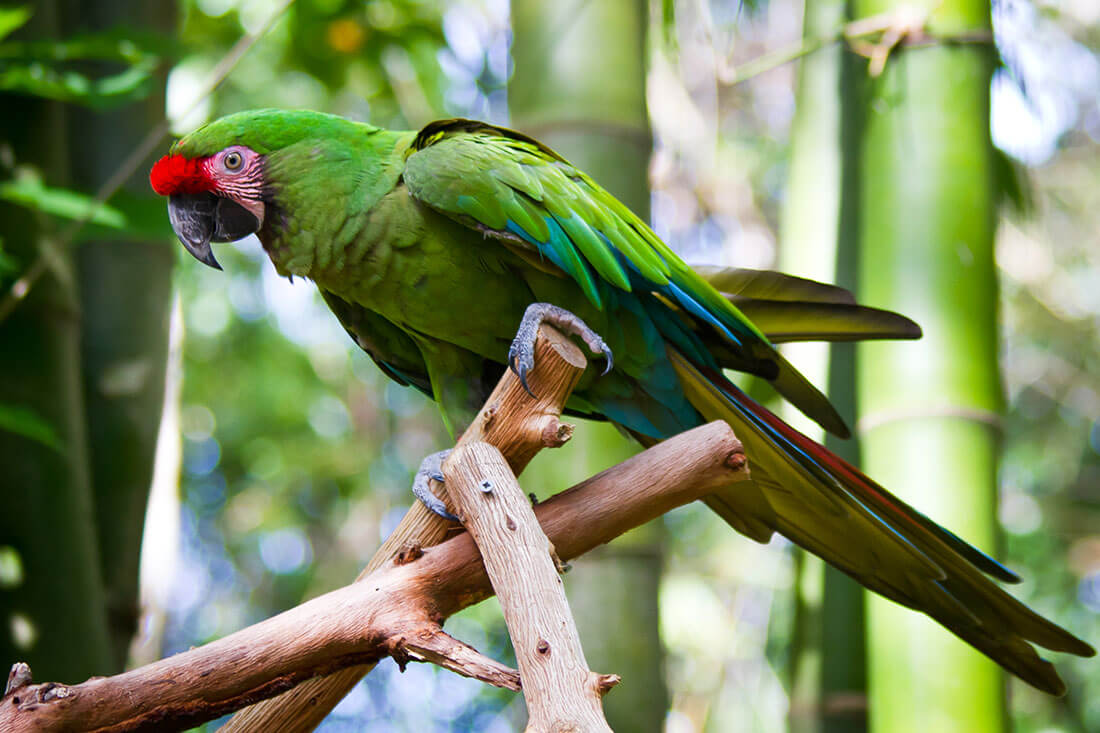
| Size | 70–76 cm |
| Habitat | Forests in Mexico to South America |
| Status | Vulnerable |
| Fact | Named for its olive green plumage |
The military macaw is a medium-sized macaw species that lives in the forests of Mexico and South America. The predominantly green plumage of the bird reminds one of a military parade uniform. The military macaw is currently classified as vulnerable due to their capture to satisfy the high demands of the pet trade industry.
12. Blue-throated Macaw (Ara glaucogularis)
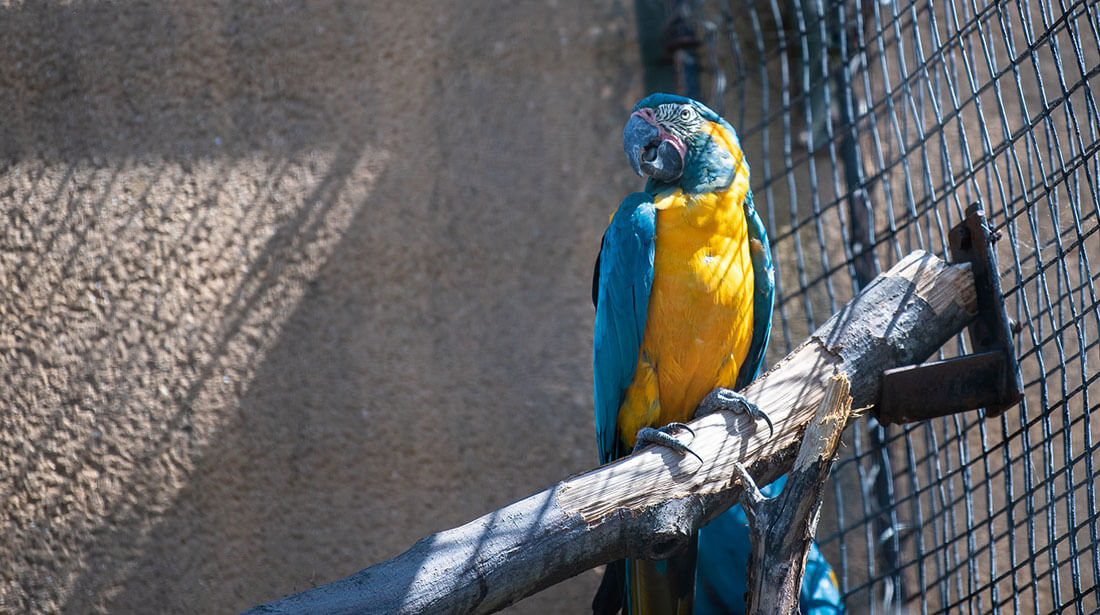
| Size | 85 cm |
| Habitat | Bolivia |
| Status | Critically Endangered |
| Fact | A national symbolOne of Bolivia’s national symbols |
The blue-throated macaw is a species that is inhibit to Los Llanos de Moxos, north-central Bolivia. Due to the highly restricted range of this species and a small population of a few hundred individuals. The illegal pet trade considers to be the main culprit behind the demise of this species. However, regarded as one of Bolivia’s cultural heritage and critically endangered.
13. The blue and yellow Macaw (Ara ararauna)
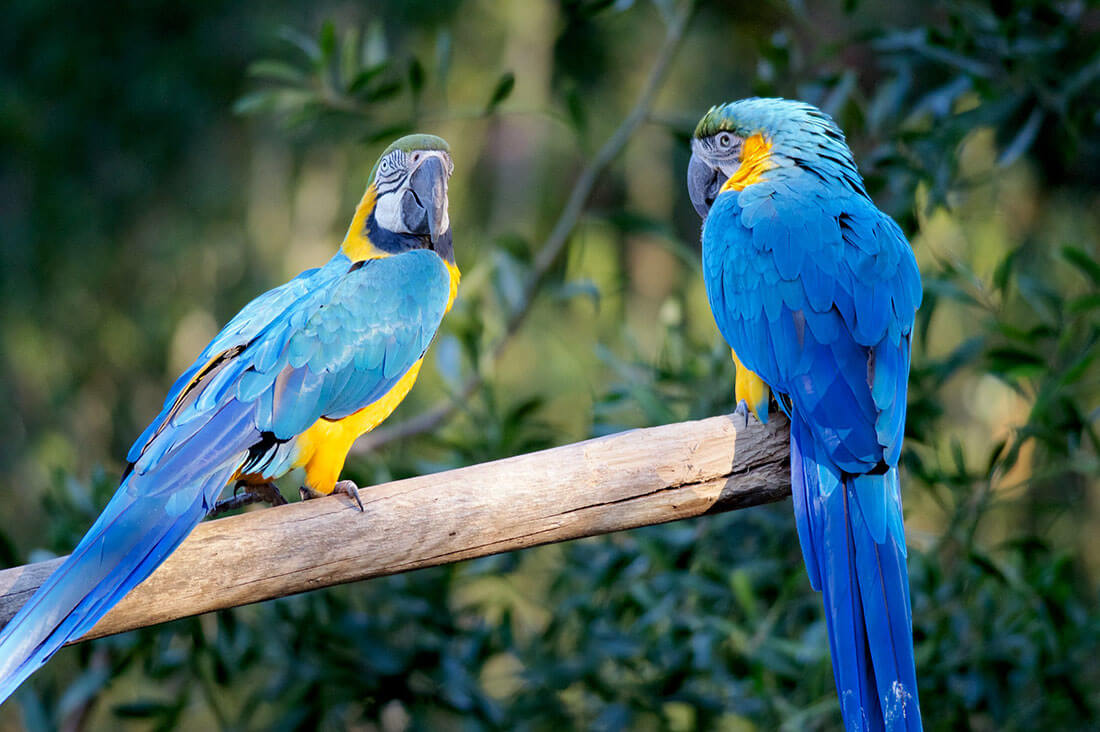
| Size | 81–91 cm |
| Habitat | South American forests and woodlands |
| Status | Least Concern |
| Fact | Known for their colorful feathers and talking ability |
This is a vibrant bird with blue top parts and yellow underparts. However, we can observe them in the forests and woodlands of tropical South America.
Related Pick: Blue and Gold Macaw Maintenance – The Ultimate Guide
The birds are extremely popular among people because of their highlighting colours, talking abilities, and close bonding to humans.
14. Spix’s or little blue Macaw (Cyanopsitta spixii)
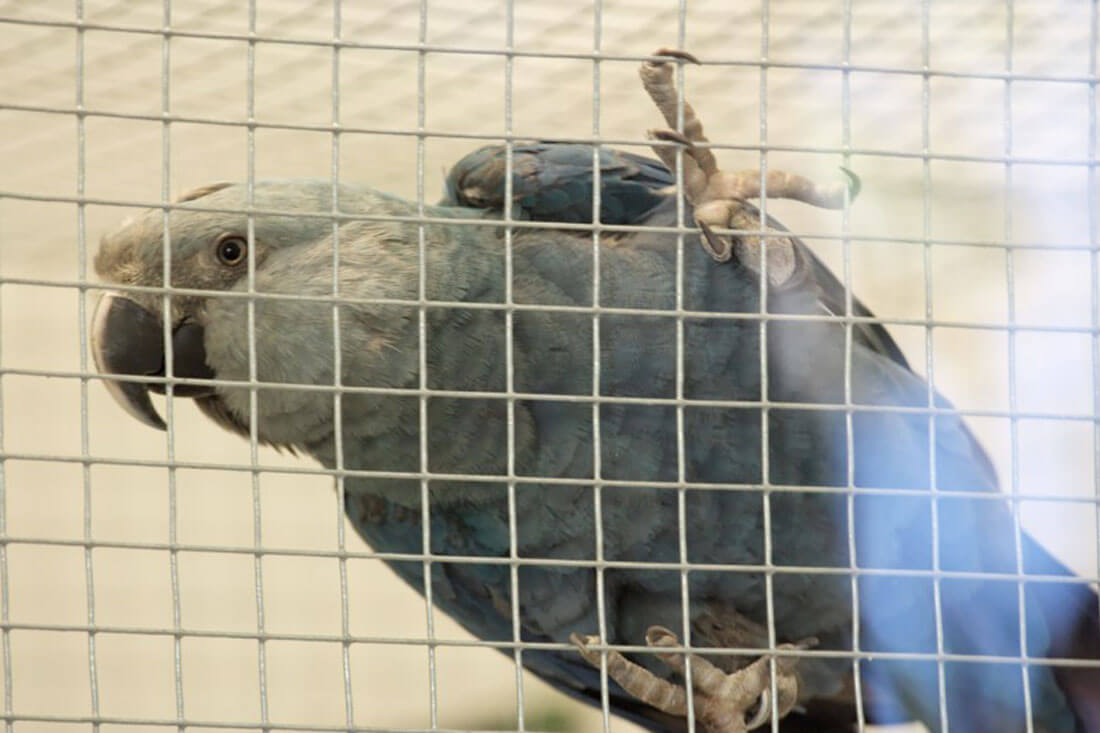
| Size | 56 cm |
| Habitat | Caatinga dry forest, Brazil |
| Status | Critically Endangered (possibly extinct in the wild) |
| Fact | Reintroduced via captive breeding |
This is a native bird of Brazil. The bird is medium-size and weighs about 300 gms. This bird exhibits various shades of blue. The species had a highly restricted range due to its heavy dependence on the seeds and nuts of the Caraiba tree and similar flora in the Caatinga dry forest climate of Brazil.
Related Pick: The Blue Macaw Extinction
Due to the destruction and degradation of habitat, the Spix’s macaw experienced a massive decline in population. Today, the IUCN critically classifies these birds as endangered, while some experts believe they are already extinct in the wild.
15. Lear’s blue or indigo macaw (Anodorhynchus leari)
| Size | 75 cm |
| Habitat | Northeastern Brazil |
| Status | Endangered |
| Fact | Relies on licuri palms |
This macaw is all blue and a large parrot living in Brazil. Lear’s macaw is 75 cm long and its weight is 950g. The Lear’s macaw has a highly restricted range confined to parts of northeast Brazil. Here, the bird inhabits stands of licuri palm. Due to its restricted range and highly restricted habitat, the Lear’s macaw is an endangered species of bird.
16. Hyacinth Macaw (Anodorhynchus hyacinthinus)
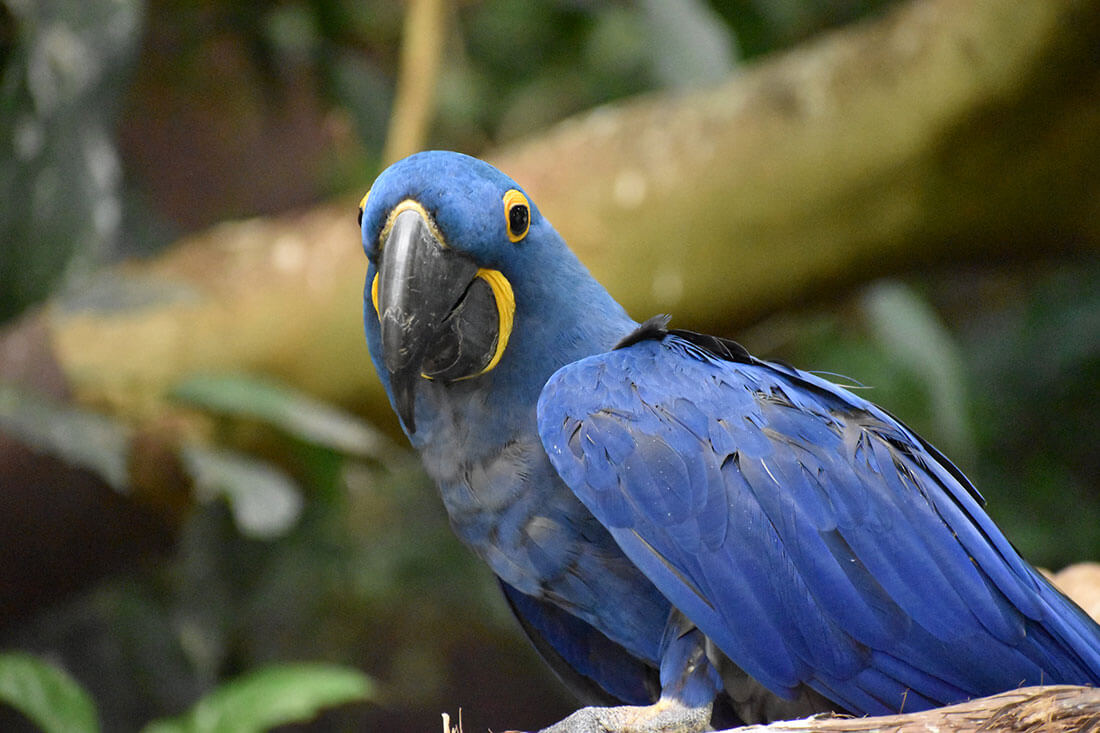
| Size | 100 cm, the largest parrot |
| Habitat | Forests, palm groves |
| Status | Vulnerable |
| Fact | Strong enough to crack coconut shells |
The hyacinth macaw is a vulnerable macaw species that inhabits eastern and central South America. It is the longest among all species of parrots with a length of about 3.3 feet. Furthermore, it is the heaviest among all species. The flightless kakapo is heavier than the hyacinth macaw. Trapping of wild birds for the pet trade and habitat loss threaten the survival of these birds today.
17. Glaucous Macaw (Anodorhynchus glaucus)
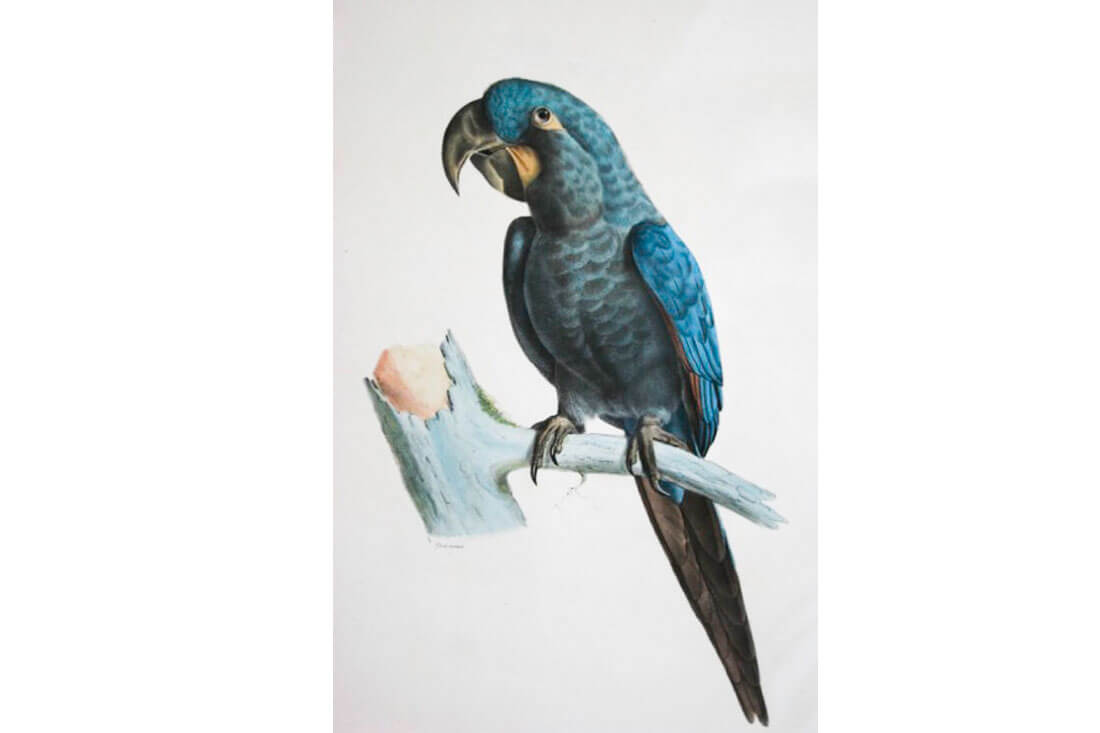
| Size | 70–75 cm |
| Habitat | Paraguay, Argentina, Bolivia |
| Status | Critically Endangered (possibly extinct) |
| Fact | No verifiable sightings in decades |
Critically endangered species of South American parrot that is generally believed to be extinct. The Glaucous macaw was native to parts of Paraguay, Argentina, and Bolivia. Rumors of sightings of this bird in the wild have kept its status at critically endangered instead of extinct.
18. Hahn’s Macaw (Diopsittaca nobilis nobilis)
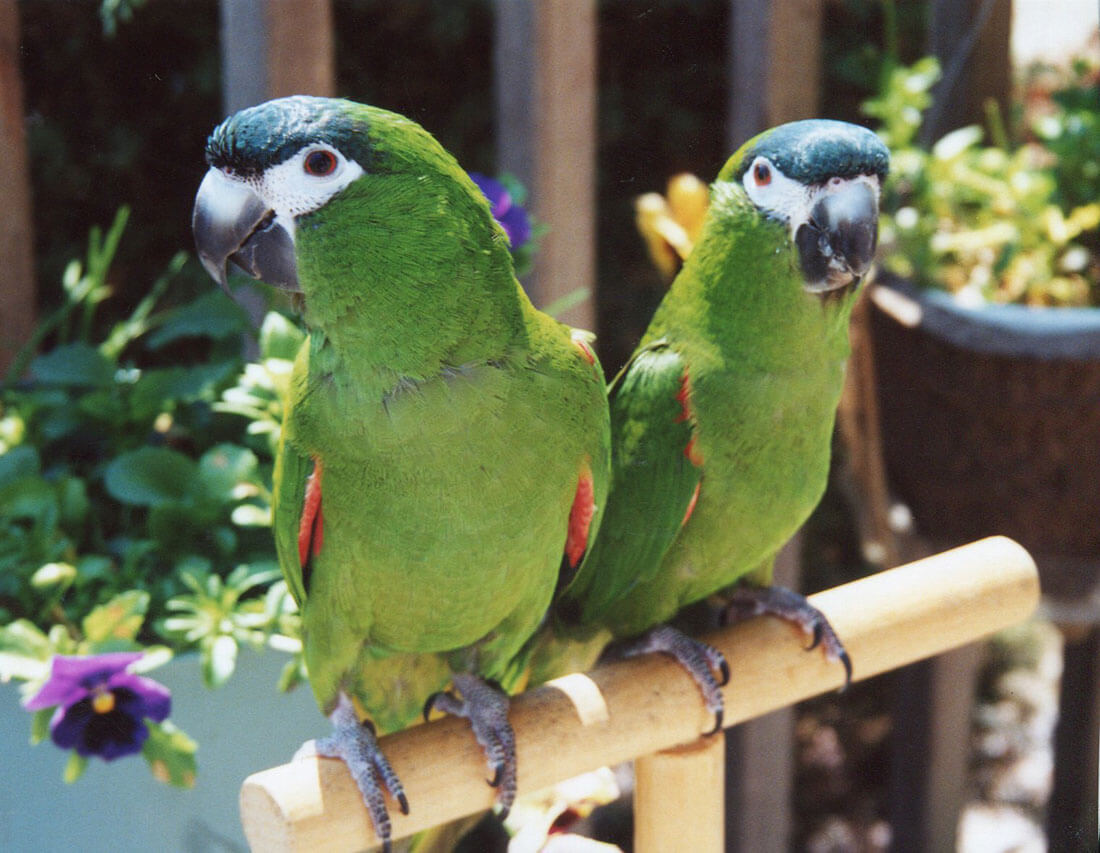
| Size | 30 cm |
| Habitat | Venezuela, Guianas, Brazil |
| Status | Least Concern |
| Fact | Small, trainable, and vocal |
Hahn’s macaws are the smallest and the most known among the macaws. These macaws are native to Venezuela, the Guianas, Bolivia, Brazil, and Peru, where they inhabit tropical lowlands, savanna, and swamplands. Hahns are also very intelligent and quick to learn vocalizations and tricks.
Groups of Macaws
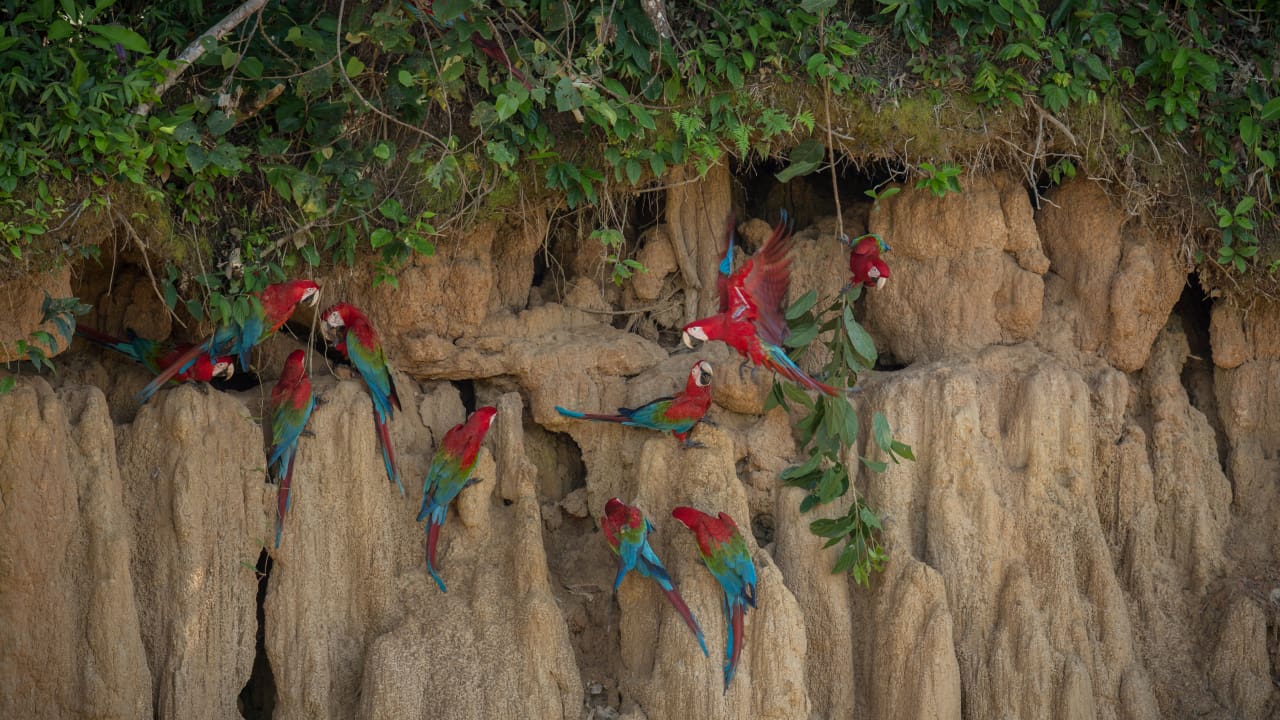
1. Genus Ara
This genus contains 8 of the 17 species. The most easily identifiable are the large macaws because of their large size and realistic colours:
- Blue and Gold Macaw
- Green or red-and-green-winged Macaw
- Scarlet Macaw
2. Genus Primolius
The macaws in the Genus Primolius are the smaller macaws. The Macaw species currently in this group are:
- Yellow-collared Macaw
- Illiger’s Macaw or Blue-winged Macaw
- Blue-headed Macaw
3. Genus Diopsittaca
These are also the smaller macaws, and this group holds three subspecies of the Red-shouldered Macaw, which are:
- Hahn’s Macaw
- Noble Macaw
- Long-winged Macaw
- Genus Anodorhynchus
These types of macaws are highly endangered, including:
- Hyacinth Macaw
- Glaucous Macaw
- Lear’s Macaw
5. Genus Orthopsittaca
In this genus, there is only one mini macaw. This Macaw is easy to catch and is very difficult to keep in captivity due to a highly specialized diet. Moreover, it is also very difficult to breed:
- Red-bellied Macaw
6. Genus Cyanopsitta
This genus contains only one species, and it is very rare and critically endangered:
- Spix’s or Little Blue Macaw
Macaws by Genus – Summarized
| Genus | Species |
| Ara | 8 large macaws (e.g., Scarlet, Blue-and-Gold) |
| Primolius | 3 small macaws (Yellow-collared, Blue-headed, Illiger’s) |
| Diopsittaca | Red-shouldered macaw and its subspecies |
| Anodorhynchus | Hyacinth, Lear’s, Glaucous (all endangered) |
| Orthopsittaca | Red-bellied Macaw |
| Cyanopsitta | Spix’s Macaw |
Sizes of Macaws
Types of Macaws range dramatically in size, with the largest being the Hyacinth Macaw to the smallest being the Red-shouldered Macaw.
All macaws share the same physical characteristics. They all have long tails, slim bodies, and broad heads. Whereas they differ in size and the breathtaking colours of their feathers. The large and mini macaws occur naturally, and most of them are endangered.
You Might Like to Read: Amazon Rainforest Plants and Trees with Numerous Qualities
Types of Macaws are divided into three groups. The first two groups are also Large Macaws and Mini Macaws (true Macaws). The third group is the captive-bred Hybrid Macaws, developed by crossing two different Macaw species to create F1, F2, and further hybrid generations.
Macaw Size Comparison
- Largest: Hyacinth Macaw – up to 100 cm
- Smallest: Red-shouldered Macaw – 30 cm
All of the macaws have long tails, curved beaks, and vibrant feathers. They range in care needs, habitat preferences, and conservation status.
Large Macaws
There are 11 living species of the Large Macaw:
- Blue and Gold Macaw
- Blue-throated Macaw
- Buffon’s Macaw
- Glaucous Macaw
- Green or red-and-green-winged Macaw
- Hyacinth Macaw
- Lear’s, Blue or Indigo Macaw
- Military Macaw
- Red-fronted Macaw
- Scarlet Macaw
- Spix’s or Little Blue Macaw
Mini-Macaws
There are six small types of macaws in this group:
- Blue-headed Macaw
- Illiger’s blue Macaw
- Severe Macaw
- Red-bellied Macaw
- Red-shouldered Macaw
- Yellow-collared Macaw
Hybrid Macaws
Hybrid macaws are a mix of two macaw species. Though not naturally occurring, they are collected for their unique coloration. There are more than 35 types of hybrid macaws.
Hybrid Generations:
Below are a few numbers of hybrids that are present in each generation of crosses:
- First-generation F1 hybrid macaws: 15 types
- Second generation F2 hybrid macaws: 16 types
- Third generation F3 hybrid macaws: 5 types
Facts Summary
- Macaws have a beautiful appearance that’s also well adapted to their environment
- Macaws are the largest type of parrot
- Their habitat is the tropical rainforest
- Macaws have a strange connection with poison
- Macaws usually mate for life
- They are pretty deafening
- Some macaws can copy human speech
- Long-lived birds
- Nearly all categories of Macaws are either threatened, critically endangered, or extinct
FAQs
For the most part, wild macaws are an endangered, threatened, or already extinct species, due to the loss of habitat and the pet trade.
In captivity, they can live as long as 50–80 years or longer.
Some birds can mimic human speech, such as Blue and Gold Macaws and Hahn’s Macaws.
Smaller macaws, like a Hahn’s or a Yellow-collared, are more manageable.
Final Thoughts
Macaws are some of the most iconic and intelligent birds on the planet. Whether flying above the rainforest or cuddling with human caretakers, the parrots are brimming with life and personality. Their future depends on preserving their habitats and combating the illegal trade.
You Might Like to Read: Foods That Are Poisonous to Macaws
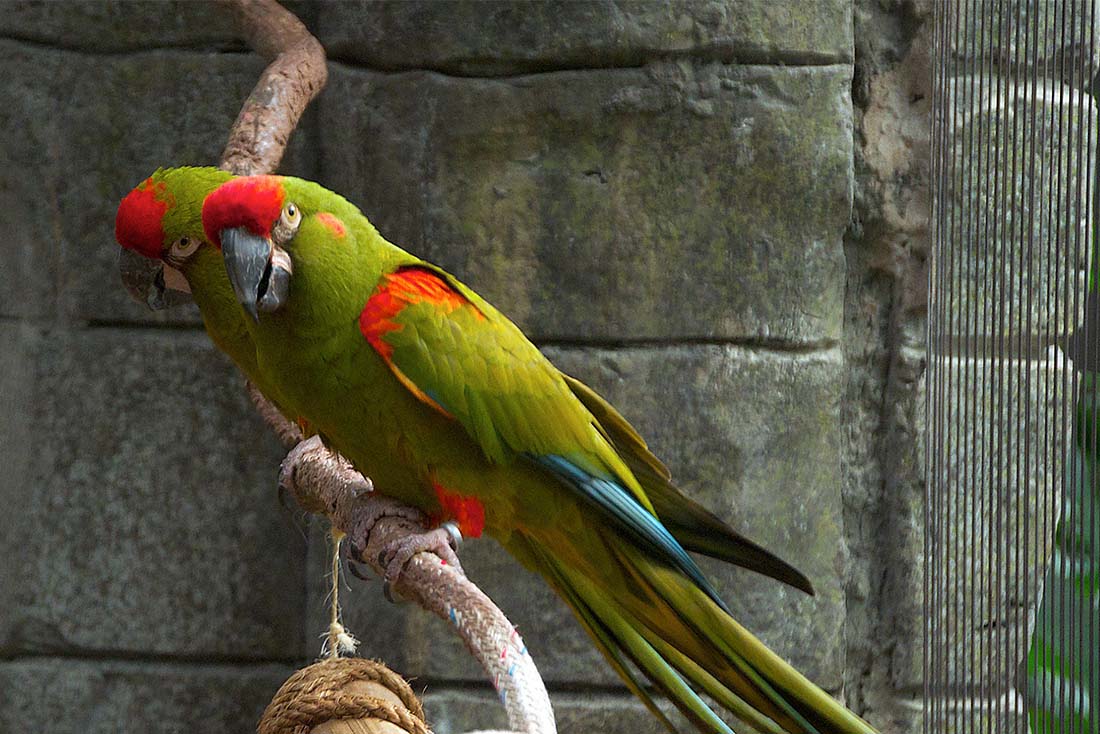
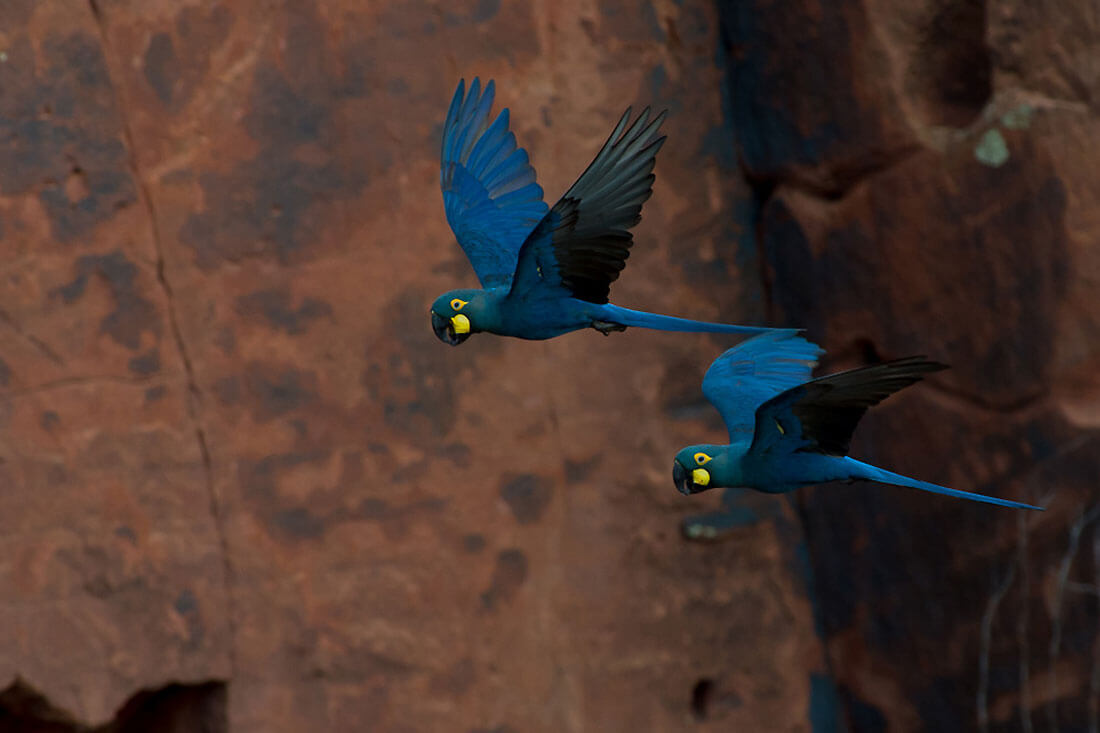
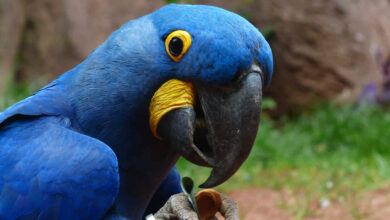
The photo for the Red-fronted macaw is a photo of a different macaw, NOT a red- fronted macaw.
Hi Roberta, Thanks for the correction